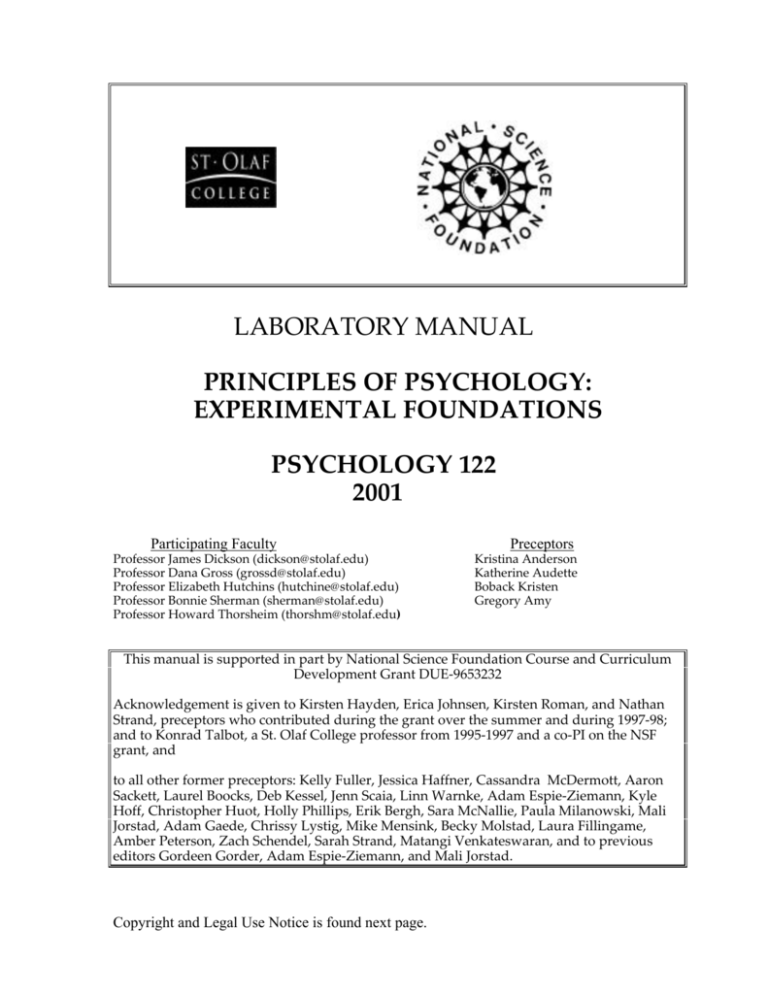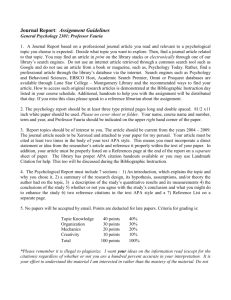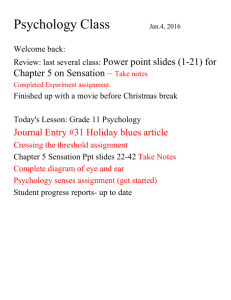
LABORATORY MANUAL
PRINCIPLES OF PSYCHOLOGY:
EXPERIMENTAL FOUNDATIONS
PSYCHOLOGY 122
2001
Participating Faculty
Professor James Dickson (dickson@stolaf.edu)
Professor Dana Gross (grossd@stolaf.edu)
Professor Elizabeth Hutchins (hutchine@stolaf.edu)
Professor Bonnie Sherman (sherman@stolaf.edu)
Professor Howard Thorsheim (thorshm@stolaf.edu)
Preceptors
Kristina Anderson
Katherine Audette
Boback Kristen
Gregory Amy
This manual is supported in part by National Science Foundation Course and Curriculum
Development Grant DUE-9653232
Acknowledgement is given to Kirsten Hayden, Erica Johnsen, Kirsten Roman, and Nathan
Strand, preceptors who contributed during the grant over the summer and during 1997-98;
and to Konrad Talbot, a St. Olaf College professor from 1995-1997 and a co-PI on the NSF
grant, and
to all other former preceptors: Kelly Fuller, Jessica Haffner, Cassandra McDermott, Aaron
Sackett, Laurel Boocks, Deb Kessel, Jenn Scaia, Linn Warnke, Adam Espie-Ziemann, Kyle
Hoff, Christopher Huot, Holly Phillips, Erik Bergh, Sara McNallie, Paula Milanowski, Mali
Jorstad, Adam Gaede, Chrissy Lystig, Mike Mensink, Becky Molstad, Laura Fillingame,
Amber Peterson, Zach Schendel, Sarah Strand, Matangi Venkateswaran, and to previous
editors Gordeen Gorder, Adam Espie-Ziemann, and Mali Jorstad.
Copyright and Legal Use Notice is found next page.
Principles of Psychology: Experimental Foundations
St. Olaf College
Psychology 122
Table of Contents
Introduction .............................................................................3
1. Observing Children's Play Behavior ..................................11
2. Information Literacy.............................................................21
3. Neuropsychology: Handedness..........................................34
4. Psychopharmacology ...........................................................50
5. Attention and Brain Activity ...............................................58
6. Statistics Follow-up on Play Lab.........................................72
7. Sensation and Perception: Illusions....................................88
8. Animal Learning ...................................................................94
9. Eyeblinks and Eye Movements in Cognition..................101
Appendices
Required Lab Readings
Citation Skeleton for each lab
116
118
Note: Author contact information: Dr. Bonnie Sherman, Psychology Department, St. Olaf College, 1520
St. Olaf Avenue, Northfield, Minnesota 55057 USA. (507) 646-2222 or 646-3146. Email:
sherman@stolaf.edu
Copyright © 2002 by Bonnie Sherman, James Dickson, Dana Gross, Elizabeth Hutchins, & Howard
Thorsheim. Used under license by the Society for the Teaching of Psychology (APA Division 2). All
rights reserved. You may download and print multiple copies of this material for your own personal use,
including use in your classes and/or sharing with individual colleagues as long as the authors’ names and
institution and the Office of Teaching Resources in Psychology heading or other identifying information
appear on the copied document. No other permission is granted to you to print, copy, reproduce or
distribute additional copies of this material. Anyone who wishes to produce copies for other purposes
must obtain the permission of the authors.
Introduction
In this section of the Psychology 122 Laboratory Manual, we will introduce you
to the organization of the laboratory component of the course, and the contents
of this manual.
Laboratory Organization/Schedule
During the first laboratory session your lab will be subdivided into two sections
(A1/A2 for Tuesday labs, or B1/B2 for Wednesday labs). This division will set
the lab schedule that you will follow for the remainder of the semester. Content
of the laboratory curriculum is identical for all sections; only the sequence
differs.
Preceptors
At the top of the lab schedule sheet you will find the name of the preceptor who
will be with your group for the duration of the semester. The preceptors are
upper-class students in psychology who have indicated an interest in teaching,
either in secondary school or college. They will be primarily responsible for
teaching and grading each of the labs, although a faculty member will be present
in the laboratory at all times to answer questions and assist the preceptor should
questions arise. The preceptors will grade laboratory work, with supervision by
the faculty. Please note that preceptors are more than laboratory assistants; they
are students registered for an upper level class on laboratory teaching and they
work closely and meet frequently with each other and with the four faculty
participating in the course. They teach one laboratory section and move with
this section from one laboratory to another week by week, working first with one
faculty member in one space, and then with another faculty member in another
space. They are the only teacher who stays with the class throughout the
semester.
Grading
Your grade in Psychology 122 is earned through completion of the class
component (59.45%) and the laboratory component (40.55%). The following
table shows how all points are allocated:
Research: Setting, Design, and Data Collection
Scientific research always consists of three components: a research setting, a
research design, and a data-collection technique. Let’s look briefly at each of
these components.
In the traditional experimental approach to research, behavior is studied in a
controlled laboratory setting in which variables are manipulated and isolated. It
is important to realize, however, that observations of behavior in natural settings
often influence the hypotheses that are tested in laboratories. Therefore, research
is often conducted in natural settings (“the field”). The naturalistic approach is
also valuable because it enables researchers to study people or animals and their
behavior in complex, real-life situations.
There are three basic types of research designs. The experimental method
systematically investigates one or more dependent variables by manipulating
one or more elements in the environment (the independent variables).
Comparing the effectiveness of two different methods for teaching children to do
math is an example of an experiment, but children must be randomly assigned to
the two groups in order for the experiment to be considered valid. A
correlational study attempts to discern a connection between two or more
variables. A strong correlation implies a connection between variables; it does
not indicate causation. As an example, the association between parents’
discipline styles and the psychological development of their children is almost
always studied using a correlational approach; that is, families are studied as
they are, rather than being told by a researcher how to behave. A descriptive
study describes a specific phenomenon without systematically investigating
relationships between variables. Descriptive studies are often useful when a
researcher is beginning to learn about the phenomenon. For example,
researchers interested in children’s reactions to being dropped off or picked up at
daycare may simply observe these situations and describe what they see.
Information from a descriptive study is often a good source of ideas for
correlational studies and experiments.
There are two types of data-collection methods: self-report and observational.
Self-report methods rely on subjects to provide information upon the request of
the researcher. Questionnaires and interviews are typical of this method.
Observational techniques do not rely on subjects’ self-descriptions for data
collection. Instead, the researcher makes observations in a consistent and
objective manner.
This diagram in Figure 1 outlines how these three components can be combined.
For example, the lower right-hand box in front designates a descriptive study,
conducted in the field, that obtains its data via observation.
Lab
Experiment
Field
Correlational
Study
Descriptive
Study
Self-report
Observational
Figure 1. Three dimensions of research strategy (Gray, 1991)
Citation Skeletons
In Psychology 122 we hope to develop your reading/thinking skills in dealing
with the psychological literature. We also wish to prepare you for each week’s
lab. To that end, a sequenced set of activities will be part of the laboratory
program. Pre-laboratory assignments will be assigned for labs 2-9. These
assignments are lab specific and need to be completed before attending lab every
week. Individuals who do not complete the pre-labs may not attend the lab
until they do. No Exceptions!
These assignments, known as “Citation Skeletons” will help you analyze and
remember the main ideas of assigned pre-laboratory readings. They will also
require you to read your lab manual before coming to lab. A sample “Citation
Skeleton” is reproduced below. Point values for each part are also indicated.
1. Reference :(As illustrated in the references section of each lab)-.5 point
2. Institutional Affiliation of first author: (Often listed on first page of article itself)-.5
point
3. Type of article or chapter: (e.g., research study; literature review; popular press
article)-.5 point
4. Goal of article: (What are they trying to do?)-.5 point
For Review articles: Skip to backside of Citation Skeleton, and fill that out.
For Research Studies: Fill out the following, plus backside of Citation Skeleton. [If the
research article describes several studies, pick one to use in filling out the rest of the
material of this Citation Skeleton]
5. Sample and size: (If an empirical study, this information usually found in Methods
section)-.5 point
6. List terms defined conceptually; (Usually found in Introduction or Discussion
sections)-.5 point
7. Operational definition of one key concept
to collecting data)-.5 point
(Usually found in methods section; vital
8. Design: (Usually found in Methods section)-.5 point
9. Procedure: (Usually found in Methods section)-.5 point
10. Findings/Results: (Usually found in Results section; state in narrative form)-.5 point
11. Steps or conclusions suggested by the article: (Usually found in the Discussion
section; what do the data mean?)-1 point
12 Criticisms of the article: (What might have been done better? What limitations exist in
the study?)-.5 point
15. So what next? (Give some ideas for further research that could be done. What would
you like to investigate further?)-.5 point
16. Lab-specific question 1:-1.5 points
17. Lab-specific question 2: 1.5 points
Laboratory Notebook
Each student will need to purchase an 80-sheet AMPAD # 26-252 Composition
Book (lined, not graph paper) with sewn-in pages to serve as a laboratory
notebook. It is available from the bookstore for about $2.00. You will also need
to purchase rubber cement to use to paste data into your notebook
(NOTEBOOKS WILL NOT BE ALLOWED TO HAVE ANY LOOSE MATERIAL
IN THEM). As soon as you get your notebook, put your name on it, and then
number each side of each page in the upper right corner. You will number pages
consecutively up to 160. Your notebook will be used to take notes during each
laboratory period, and also for preparation of a formal write-up of each
laboratory experiment. The “notes” section will be used for informal recording
of data, comments, etc. Start each lab on a new page, and include title of the
lab, date, and names of lab partners. “Formal” write-up of each lab will be done
using the pages immediately after the “notes” section. For each lab, you will be
expected to include the following information in your Formal write-up:
INFORMAL WRITE-UP
• Notes: This section contains any rough notes that you make during the lab
exercise (data, pictures, facts, etc.). Answers to critical thinking questions
also belong in this section. Your preceptor should be able to easily identify
these answers.
FORMAL WRITE-UP
• Introduction: Here, you introduce the problem to be investigated, comment
briefly on the assigned reading, and use it to develop a hypothesis for the
week’s experiment.
• Method: includes a statement regarding your experimental subjects,
materials or apparatus, and procedures.
• Results: This section is for your data, which may be displayed numerically,
graphically, with tables, and with figures. All graphs tables and figures
need to be labeled. Narratively describe your data in this section. Save
explanation of the findings for the Discussion section.
• Discussion: In this section, you reflect on the results of your study, and
interpret your findings in relation to your initial expectations. It is also
important to integrate your findings with the topic(s) discussed in the
“Required Lab Reading.” That is, how do your findings relate to what you
included about the readings in your Introduction section? You may also
need to answer one or more of the discussion questions. This section should
also include possible sources of error and ideas for future research.
There is no required length for lab write-ups, but the maximum is 8 pages per
lab, so carefully choose what you are going to write. You should be as concise as
possible, but need to include all relevant information. Do not ramble on to fill up
space. Meaningless paragraphs will not impress your preceptor.
Poster Display
Student lab groups will prepare a poster display of the play project for
presentation at the final lab sessions. You are required to use a poster
dimensioned 22 x 28 inches. You may choose to purchase whatever color poster
board you wish from the Bookstore supply, but you must use one 22 x 28 inches.
As you will see later, the play project runs through the most of the semester, and
serves as an integrating laboratory experience. For the field work portion of this
project you will be given a letter of introduction that you may show in case
anyone questions your activity.
Laboratory Examination
There will be a laboratory examination at the end of the semester. You will be
asked to use the skills you have developed in the 122 lab in
developing/evaluating the design of an experiment, define some terms from lab,
etc. Additional details will be forthcoming.
The Laboratory Manual
Each of the laboratory exercises in this manual has been prepared according to a
standard format:
Introduction: The purpose of the laboratory is introduced. Basic concepts
are discussed. The framework for the laboratory (i.e., where it “fits” in the
domain of psychology) is established.
Objectives: This is a bulleted list of the specific objectives of each exercise.
As you conduct and write up each experiment, you should refer back to this list
and comment (in your lab notebook) on your findings in the context of these
objectives.
Terms: This is a list of important terms for each laboratory. You will need
to master this vocabulary in order to appreciate fully each laboratory exercise.
Mastery of these terms is vital for successful completion of the lab final
examination.
Critical Thinking Questions: Throughout the lab you will come across
questions that are surrounded by a box and are labeled with a CT symbol.
Why do you think there is no sound from the
station?
CT
These are critical thinking questions, and serve to broaden and deepen your
understanding of the laboratory exercise. All of these questions should be clearly
labeled and answered in the notes section of your lab write-up
Methods: The specific details to be followed in each exercise are included
in this section. Careful reading prior to each lab period (as well as willingness to
ask the Preceptor or Professor in lab) will facilitate data collection, analysis, etc.
In most cases, the Methods are further subdivided into the following three
subsections:
•
Participants/Subjects– Description of (human) participants or
(infrahuman) subjects.
•
Materials/Apparatus – Materials and/or apparatus used in the
experiment. Research reports include this information so that
someone else will be able to replicate your study.
•
Procedure – These are the specific procedures/steps you should
follow as you carry out your study. These procedures also reveal
another aspect of the report, one that will enable replication.
Discussion Questions: Each lab concludes with discussion questions that
will help you contemplate your laboratory exercise. All discussion questions
should be answered in the discussion section of your laboratory write-up, unless
otherwise specified by your preceptor. Preceptors may choose to address the
questions as a class, or may have you complete only a few of the questions.
Preceptors will specifically state which questions must be answered for each lab.
References: We have included several different forms of reference
material for you.
Required Lab Reading: This is the article you are to have read prior to
each laboratory period. It is also the article, which will be the basis for
your “Citation Skeleton." These articles can be obtained from the reserve
desk in Rolvaag Library. You are also expected to incorporate appropriate
reference to this article in your report write-up. This article reference is
highlighted in the laboratory manual by a gray box, e.g.:
Guttman, N. & Kalish, H.I. (1966). Experiments in discrimination. In T. Verhave
(Ed.), The Experimental Analysis of Behavior (pp. 209-216). New York: AppletonCentury-Crofts.
Suggested Readings: This is a list of other resources (books, journal
articles) which you may wish to explore should you wish to better understand in
the area of investigation which is covered by each laboratory.
Web Links – For many lab, a few annotated links are provided to
world wide web pages with material relevant to the investigation.
Just type the URL (e.g., http://www.med.harvard.edu/AANLIB/
into your favorite browser (Netscape Navigator or Internet
Explorer) and examine this potentially helpful (and in many cases,
fascinating) material.
Lab Procedure Questions
At various points in the procedure of the laboratory exercises, you will find
questions. These questions will be written in bold and answers to them must be
included in the Notes section of your lab write-up.
The faculty and preceptors wish you the best with this course. Please do not
hesitate to contact us with any suggestions for improvements!
Welcome to the fascinating world of psychology!




